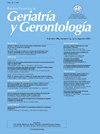土耳其版老年人社会虚弱指数的有效性:预测死亡率的社会属性指数。
Q3 Medicine
引用次数: 0
摘要
目的:本研究旨在检验土耳其版社会虚弱指数在老年人中的有效性。首先对老年人进行霍奇金森心理测试。得分在 6 分或以上的老年人被纳入研究范围。为了评估 "社会虚弱指数 "的有效性,对参与者使用了社会包容量表、老年人生活质量简表(OPQOL-Brief)和卢本社会网络量表。为确定 "社会虚弱指数 "的可靠性,每隔一周对未接受任何治疗的老年人进行一次重新测试。使用 AMOS 23.0 进行了确认性因子分析,以确定其结构是否符合原始模型。对于并发有效性,则采用了相关分析。采用类内相关系数(ICC [2,1],绝对一致,双向随机效应模型)来确定量表的可靠性:土耳其版社会虚弱指数与原文所述模型的拟合度被确定为可接受-优秀(人口统计学(DEM)、一般资源和生活史(GRLH)、社会活动(SA)和满足基本社会需求(FBSN))(CMIN/DF=1.36、GFI=0.93、IFI=0.90、RMSEA=0.06 和 SRMR=0.07)。在为确定其并发有效性而进行的相关性分析中,社会虚弱指数与社会包容量表呈中度相关(r:-0.47;p(2,1)=0.90,%95 CI 0.84-0.93,p 结论:土耳其版社会虚弱指数是有效的,可用于根据估计的社会风险预测死亡风险。改编后的社会虚弱指数未能充分捕捉到与网络和社会支持相关的方面:临床试验编号:NCT06288789。本文章由计算机程序翻译,如有差异,请以英文原文为准。
The validity of Turkish version of Social Frailty Index in older adults: An index of social attributes predictive of mortality
Purpose
The aim of this study was to examine the validity of Turkish version of Social Frailty Index in older adults.
Material and methods
102 older adults aged 65 and over were included in the study. Hodkinson Mental Test was first applied to older adults. Older adults who scored 6 points or above were included. To evaluate the validity of “Social Frailty Index”, Social Inclusion Scale, Older People's Quality of Life-Brief (OPQOL-Brief) and Lubben Social Network Scale were applied to the participants. To determine the reliability of “Social Frailty Index”, the test was re-tested at one-week intervals on older adults who did not receive any treatment. Confirmatory factor analysis AMOS 23.0 was used to determine the conformity of the structure to the original model. For concurrent validity, the correlation analysis applied. Intraclass correlation coefficient (ICC [2,1], absolute agreement, 2-way random effects model) was used to determine the reliability of the scale.
Results
The fit of the Turkish version of Social Frailty Index to the model described in the original article was determined to be acceptable-excellent (Demographics (DEM), General Resources and Life History (GRLH), Social Activities (SA) and Fulfillment of Basic Social Needs (FBSN)) (CMIN/DF = 1.36, GFI = 0.93, IFI = 0.90, RMSEA = 0.06 and SRMR = 0.07). In the correlation analysis conducted to determine its concurrent validity, Social Frailty Index had a moderate correlation with Social Inclusion Scale (r: −0.47; p < 0.001) and OPQOL-Brief (r: −0.47; p < 0.001). Social Frailty Index had no correlation with Lubben Social Network Scale (r: −0.03; p: 0.81). Test–retest reliability of Social Frailty Index was excellent [ICC(2,1) = 0.90, %95 CI 0.84–0.93, p < 0.001].
Conclusion
The Turkish version of the Social Frailty Index is valid and can be used to predict mortality risk based on the estimated social risk. The adapted Social Frailty Index is not adequately capturing aspects related to the network and social support.
Clinical trials number: NCT06288789.
求助全文
通过发布文献求助,成功后即可免费获取论文全文。
去求助
来源期刊

Revista Espanola de Geriatria y Gerontologia
Medicine-Medicine (miscellaneous)
CiteScore
1.90
自引率
0.00%
发文量
62
审稿时长
85 days
期刊介绍:
Una revista de gran prestigio por sus artículos originales de investigación y revisiones. Permite cubrir todas las áreas de la medicina pero siempre desde la atención al paciente anciano, y está presente en los más reconocidos índices internacionales.
 求助内容:
求助内容: 应助结果提醒方式:
应助结果提醒方式:


